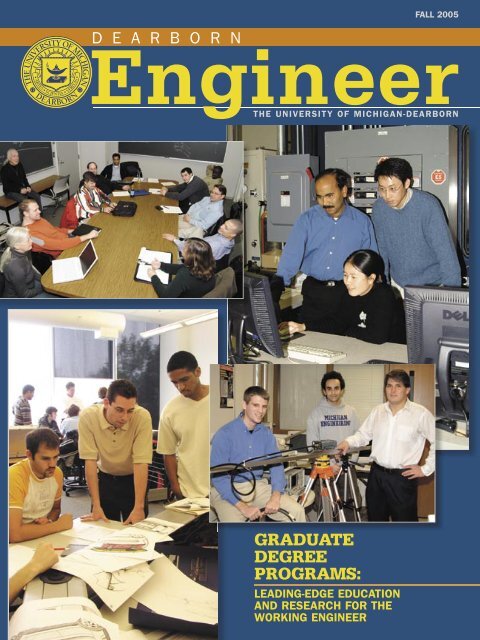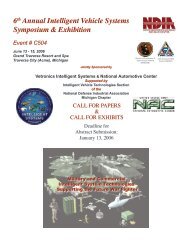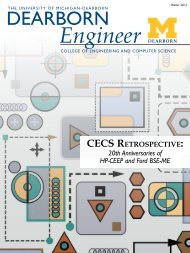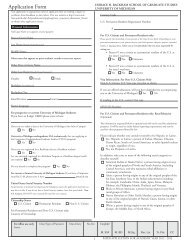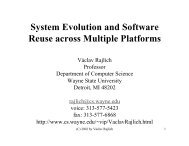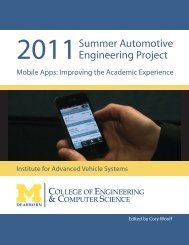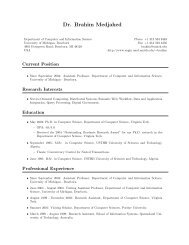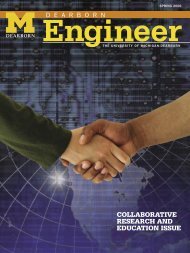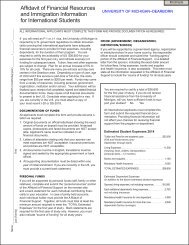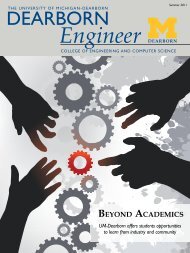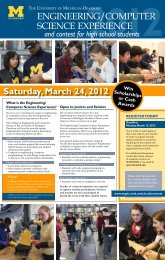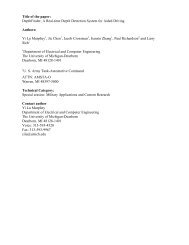Dearborn Engineer, Fall 2005 - College of Engineering & Computer ...
Dearborn Engineer, Fall 2005 - College of Engineering & Computer ...
Dearborn Engineer, Fall 2005 - College of Engineering & Computer ...
Create successful ePaper yourself
Turn your PDF publications into a flip-book with our unique Google optimized e-Paper software.
FALL <strong>2005</strong><br />
D E A R B O R N<br />
<strong>Engineer</strong><br />
THE UNIVERSITY OF MICHIGAN-DEARBORN<br />
GRADUATE<br />
DEGREE<br />
PROGRAMS:<br />
LEADING-EDGE EDUCATION<br />
AND RESEARCH FOR THE<br />
WORKING ENGINEER
The <strong>Dearborn</strong> <strong>Engineer</strong><br />
<strong>Fall</strong> <strong>2005</strong><br />
6<br />
IMSE GRADUATE PROGRAMS<br />
News from the <strong>College</strong> <strong>of</strong><br />
<strong>Engineer</strong>ing and <strong>Computer</strong> Science,<br />
University <strong>of</strong> Michigan-<strong>Dearborn</strong><br />
www.engin.umd.umich.edu<br />
Graduate Degree Programs at CECS 1<br />
CIS Graduate Degree Programs 2<br />
ECE Graduate Degree Programs 4<br />
IMSE Graduate Degree Programs 6<br />
ME Graduate Degree Programs 8<br />
Interdisciplinary Programs 10<br />
IAVS Offers Graduate Students Experience 11<br />
Ford Partnership with IAVS 12<br />
11 IAVS PROGRAMS<br />
Co-op Employer <strong>of</strong> the Year: DENSO 15<br />
DENSO Gift 13<br />
New Visiting Committee Members 14<br />
Scholarship Awards 15<br />
New Faculty Members 16<br />
Faculty Research Awards 17<br />
Student Robotics Activities 18<br />
<strong>2005</strong> Annual Alumni Awards 20<br />
Editorial Board<br />
Subrata Sengupta, Ph.D., Dean<br />
Keshav S. Varde, Ph.D., Associate Dean<br />
Editor: Kathryn Tamborino<br />
12 FORD MOTOR COMPANY FUND<br />
The <strong>Dearborn</strong> <strong>Engineer</strong> is published for the alumni<br />
and friends <strong>of</strong> the University <strong>of</strong> Michigan-<strong>Dearborn</strong><br />
<strong>College</strong> <strong>of</strong> <strong>Engineer</strong>ing and <strong>Computer</strong> Science.<br />
Send correspondence to the Editor, <strong>Dearborn</strong> <strong>Engineer</strong>,<br />
4901 Evergreen Road, <strong>Dearborn</strong>, MI 48128-1491.<br />
Regents <strong>of</strong> the University<br />
David A. Brandon, Laurence B. Deitch,<br />
Olivia P. Maynard, Rebecca McGowan,<br />
Andrea Fischer Newman, Andrew C. Richner,<br />
S. Martin Taylor, Katherine E. White,<br />
Mary Sue Coleman (ex <strong>of</strong>ficio)<br />
Citizens Advisory Committee<br />
Ismael Ahmed, Stephen T. Economy, Linda P. Kughn,<br />
Patricia Mooradian, Timothy J. O’Brien, Jon Pepper,<br />
Michael C. Porter, Maria Leonhauser Rosenau,<br />
Shirley R. Stancato<br />
18 ROBOTICS
FALL <strong>2005</strong><br />
Graduate Degree Programs at CECS<br />
In order to remain relevant, all major<br />
engineering schools cater to the needs <strong>of</strong> their<br />
students. The graduate programs at the <strong>College</strong><br />
<strong>of</strong> <strong>Engineer</strong>ing and <strong>Computer</strong> Science (CECS) go<br />
a step further and also work to meet the needs <strong>of</strong><br />
its stakeholders, the engineering companies and<br />
industries who benefit from the college’s research<br />
and highly qualified graduates.<br />
Over the past 40 years, the CECS graduate<br />
programs have sought to balance research and<br />
practice, a balance that pushes the boundaries<br />
<strong>of</strong> what is currently possible but stays rooted in<br />
practical application. This approach provides<br />
opportunities for full-time students to pursue<br />
leading-edge research while accommodating<br />
part-time students who need to solve daily problems<br />
facing them in their industry jobs. “I would<br />
say that we have succeeded in achieving this<br />
balance,” says Malayappan Shridhar, chair <strong>of</strong> the<br />
electrical and computer engineering department.<br />
More than 90 percent <strong>of</strong> the 800 graduate students<br />
enrolled at CECS are sponsored by their employers.<br />
To facilitate their education, courses are <strong>of</strong>fered in the<br />
evening or online. Some course <strong>of</strong>ferings<br />
are tailored directly to a specific company’s needs and<br />
<strong>of</strong>fered on site. “Our industry partners like to see this<br />
sort <strong>of</strong> flexibility in education, which helps to provide<br />
them with a very competent and productive technical<br />
workforce,” says Keshav Varde, associate dean <strong>of</strong> CECS.<br />
“And our students appreciate the ability to enhance their<br />
technical education without interruption <strong>of</strong> their careers.”<br />
CECS <strong>of</strong>fers both traditional and more unusual graduate<br />
programs. The traditional programs, including mechanical,<br />
electrical, and industrial and systems engineering,<br />
have been around since the 1960s, when graduate<br />
studies at CECS began. Newer programs have been added<br />
to reflect changes in industry and educational approach.<br />
“Our graduate programs in s<strong>of</strong>tware engineering, automotive<br />
systems engineering, and engineering management<br />
are nearly unique,” says Varde. “Very few institutions<br />
<strong>of</strong>fer these programs. The automotive systems program is<br />
interdisciplinary in nature in that students get exposure to<br />
important engineering disciplines that practicing engineers<br />
in automotive industry are expected to know. The s<strong>of</strong>tware<br />
engineering program blends unique and important aspects<br />
<strong>of</strong> s<strong>of</strong>tware engineering with exposure to computer science<br />
ASSISTANT PROFESSOR JIRACHAI BUDDHAKULSOMSIRI WITH HIS<br />
PROBABILITY AND STATISTICS CLASS<br />
and computer engineering. And the engineering management<br />
program is designed for engineers who need more<br />
background in management disciplines.”<br />
Graduate students in all the programs have the option to<br />
do research with faculty members, most <strong>of</strong> whom pursue<br />
multiple industry-based projects at any given time. “All<br />
<strong>of</strong> our graduate programs are staffed by faculty who are<br />
knowledgeable in the field, work in the discipline, and<br />
pursue research activities in the discipline,” says Varde.<br />
“The pr<strong>of</strong>essors at CECS are very familiar with working<br />
with industry and most have direct industry experience,”<br />
says Karl Kennedy, who received his master’s degree in<br />
electrical engineering in <strong>2005</strong>. “Most <strong>of</strong> the students are<br />
also industry pr<strong>of</strong>essionals. As a result, in the same way<br />
that the pr<strong>of</strong>essors can challenge students, the students<br />
can also challenge the pr<strong>of</strong>essors with ideas and issues<br />
from industry. It’s a good relationship.”<br />
Lisa Marie Floros, who received her master’s degree in<br />
industrial and systems engineering in 2000, concurs. “The<br />
programs <strong>of</strong>fer a wide scope <strong>of</strong> applicable study,” she<br />
says, “which translates into greater opportunities out in<br />
the workforce. You increase your skill set and become<br />
much more marketable. I really enjoyed my entire educational<br />
experience at UM-<strong>Dearborn</strong>. Looking back from<br />
where I am now, I wouldn’t change a thing.”
DEARBORN <strong>Engineer</strong><br />
<strong>Computer</strong> and Information Science<br />
Graduate Programs: Developing<br />
S<strong>of</strong>tware Skills for Today’s Market<br />
The Department <strong>of</strong> <strong>Computer</strong> and<br />
Information Science (CIS) <strong>of</strong>fers two<br />
graduate degree programs, one in computer<br />
and information science and another in s<strong>of</strong>tware engineering.<br />
The computer and information science degree is a classic<br />
computer science degree; students can study in many <strong>of</strong> the<br />
traditional areas, including operating systems, networking,<br />
computer graphics, information systems, and databases.<br />
They can also study some <strong>of</strong> the newer cutting-edge areas<br />
such as web or multimedia information systems, web<br />
services, data mining, and automotive networking.<br />
The s<strong>of</strong>tware engineering program is jointly administered<br />
with the Department <strong>of</strong> Electrical and <strong>Computer</strong><br />
<strong>Engineer</strong>ing, with an emphasis on embedded systems.<br />
“That degree will, among other things, enable graduates to<br />
manage large s<strong>of</strong>tware projects,” says William Grosky, chair<br />
<strong>of</strong> CIS. The department also participates in a third program<br />
leading to a graduate degree in information systems technology,<br />
which is primarily run out <strong>of</strong> the Department <strong>of</strong><br />
Industrial and Manufacturing Systems <strong>Engineer</strong>ing.<br />
CIS graduate students concentrate in one <strong>of</strong> multiple<br />
areas, including computer graphics and geometric<br />
modeling, computer networks, database management,<br />
information systems, s<strong>of</strong>tware engineering, and system<br />
s<strong>of</strong>tware. Each program involves a mixture <strong>of</strong> core<br />
courses, concentration courses, cognates, and a project or<br />
thesis, which students conduct under the supervision <strong>of</strong> a<br />
faculty member. The core courses cover the principles <strong>of</strong><br />
the respective disciplines, while the concentration courses<br />
address the application <strong>of</strong> those principles.<br />
Every five years, both programs are critically evaluated by<br />
both internal and external entities in order to update <strong>of</strong>ferings<br />
to meet the demands <strong>of</strong> local industries and to incorporate<br />
major developments in the disciplines.<br />
“Our s<strong>of</strong>tware engineering degree program is unique<br />
in the metro area, and I would say in the country,” says<br />
Grosky. “There are few MS programs in s<strong>of</strong>tware engineering<br />
and even fewer programs with an emphasis<br />
in embedded systems. This is especially <strong>of</strong> interest to<br />
the auto companies and the U.S. Army Tank Command.<br />
Students with this training will gain the skills to manage<br />
large s<strong>of</strong>tware projects, a skill which, so far, has not been<br />
outsourced, and probably won’t be.”<br />
Grosky remains optimistic about CIS graduate students’<br />
career choices in spite <strong>of</strong> industry trends. “Many computing<br />
jobs have certainly been outsourced,” he says, “but<br />
these are mostly among low-level programming positions.<br />
If you believe government statistics, there will be a need<br />
for many, many people with the skills taught in our programs.<br />
This view has been echoed by Bill Gates, who is<br />
going around the country promoting this position. There<br />
are many different fields that a CIS graduate can enter.<br />
We’ve even had some more entrepreneurial students go<br />
on to start their own companies.”<br />
Austin Krauss, MS in S<strong>of</strong>tware <strong>Engineer</strong>ing, <strong>2005</strong><br />
Austin Krauss earned his graduate degree in s<strong>of</strong>tware engineering (SE),<br />
with a concentration in computer graphics and user interface design,<br />
with an eye toward going into computer game development. Although<br />
he had chosen an unusual choice for s<strong>of</strong>tware development research,<br />
Krauss found support and guidance from his pr<strong>of</strong>essors. “Overall, I felt<br />
that the pr<strong>of</strong>essors were receptive to students’ needs and were aware <strong>of</strong><br />
the changes in the job market. Their motivation excited me about the<br />
research I was doing.”<br />
Today he works at the California-based Treyarch, a leading developer <strong>of</strong><br />
video games best known for its Spiderman series <strong>of</strong> titles. Krauss credits<br />
his fledgling career to the work he did in CIS. “The program allowed me<br />
to study topics specific to my area <strong>of</strong> interest under the tutelage and advice<br />
<strong>of</strong> experienced pr<strong>of</strong>essors,” he says. “This education allowed me to obtain the dream job I have today. With my<br />
background, I was able to quickly come up to speed on Treyarch’s current processes. In the future, I hope to further<br />
shape our s<strong>of</strong>tware development processes based on the concepts and theories I learned in the SE program.”<br />
2
FALL <strong>2005</strong><br />
William Grosky, Pr<strong>of</strong>essor and Chair, CIS<br />
William Grosky’s primary area <strong>of</strong> research, multimedia<br />
information systems, is essentially an extension <strong>of</strong><br />
classical database technology. While classical databases<br />
concern themselves largely with textual information,<br />
Grosky’s work allows the management <strong>of</strong> multimedia<br />
information. “Of course, one can always attach<br />
textual annotations to images or video information,”<br />
says Grosky, “but an image or a video always seems to<br />
have more information than a single person can extract.<br />
After all, an image or video can be interpreted in<br />
multiple contexts and mean many different things.”<br />
Grosky is currently working on projects related to the<br />
bioinformatics field. “The project I’m working on right<br />
now, supported by the Michigan Life Science Corridor in<br />
collaboration with Wayne State University and UM-Ann<br />
Arbor, concerns the construction <strong>of</strong> optimal surgical paths<br />
in a patient’s brain so that a neurosurgeon can efficiently<br />
remove a tumor without damaging the patient.” The techniques<br />
used rely on various data structures and algorithms<br />
devised by Grosky and his research team. A previous project<br />
used data mining techniques to predict protein interactions<br />
and was supported by the National Institute for Health.<br />
“With the growth <strong>of</strong> technology, multimedia assets<br />
have proliferated,” says Grosky, “making their efficient<br />
management a quite important research topic. The<br />
techniques we use are many, including data mining<br />
and various statistical approaches. I really like the<br />
way different areas mesh in this field.”<br />
<strong>Computer</strong> and Information Science<br />
Graduate Degree Programs<br />
• MS in <strong>Computer</strong> and Information Science<br />
• MS in S<strong>of</strong>tware <strong>Engineer</strong>ing<br />
For more information, contact William Grosky<br />
at wgrosky@umich.edu or 313-436-9145.<br />
Qiang Zhu, Associate Pr<strong>of</strong>essor, CIS<br />
One <strong>of</strong> Qiang Zhu’s current projects, sponsored by<br />
the National Science Foundation (NSF), involves the<br />
development <strong>of</strong> techniques to support efficient<br />
similarity queries in non-ordered discrete data spaces<br />
(NDDS). This project is a collaborative research effort<br />
between Michigan State University and UM-<strong>Dearborn</strong>.<br />
“Similarity searches in NDDSs are becoming increasingly<br />
important in areas such as bioinformatics, biometrics,<br />
and E-commerce,” says Zhu. “But they require robust<br />
indexing techniques, and unfortunately existing<br />
methods can’t be directly applied to them or have<br />
suboptimal performance. At present, we have developed<br />
two novel index trees to address these problems. Our<br />
theoretical and empirical studies thus far show that these<br />
techniques show a lot <strong>of</strong> promise, and we expect that the<br />
research results from the project will have a significant<br />
impact on indexing techniques in the database field.”<br />
Zhu’s other research focuses on query optimization,<br />
multidatabases, self-managing databases, and data mining,<br />
which has been supported by sponsors that include NSF,<br />
IBM, and Ford Motor Company. He has received multiple<br />
awards, including the UM-<strong>Dearborn</strong> Distinguished Faculty<br />
Research Award, the IBM Partnership Research Award, and<br />
the IBM Faculty Award. “I like to choose research areas<br />
that are not only important from a theoretical point <strong>of</strong> view<br />
but are also valuable from a practical perspective,” he says.<br />
“I enjoy dealing with challenging issues that could lead to<br />
significant results in the field.”<br />
3
DEARBORN <strong>Engineer</strong><br />
Electrical and <strong>Computer</strong> <strong>Engineer</strong>ing<br />
Graduate Programs: Building<br />
Partnerships that Extend Knowledge<br />
The Department <strong>of</strong> Electrical and <strong>Computer</strong><br />
<strong>Engineer</strong>ing (ECE) <strong>of</strong>fers rigorous programs<br />
where, as chair Malayappan Shridhar says, “hard work<br />
and conscientious effort are the only factors that affect<br />
our students’ progress.” The hard work is shared between<br />
faculty and students, he continues. “Ultimately, it is the<br />
interaction between the faculty, who try to extend the<br />
frontiers <strong>of</strong> knowledge, and students, with fresh and creative<br />
ideas, that contributes to new knowledge and discoveries.<br />
At the graduate level, it is always a partnership.”<br />
The department <strong>of</strong>fers two graduate degree programs<br />
that lead to a master <strong>of</strong> science in engineering: one<br />
focuses on electrical engineering, while the other<br />
concentrates on computer engineering. Currently, nearly<br />
140 graduate students are enrolled in the two programs.<br />
Since the field <strong>of</strong> electrical engineering is vast, students<br />
narrow their studies to one <strong>of</strong> four subcategories: control<br />
systems, which deals with the automated control <strong>of</strong><br />
processes; digital signal processing, including digital<br />
audio, filtering, and image processing; intelligent systems,<br />
which includes machine intelligence, neural networks,<br />
pattern recognition, and data mining; and automotive<br />
electronics, covering such subjects as sensors, actuators,<br />
and the control <strong>of</strong> electric vehicles.<br />
The computer engineering program <strong>of</strong>fers four concentrations<br />
as well, including s<strong>of</strong>tware development, hardware design<br />
and computer architecture, computer networks and data<br />
communications, and intelligent systems.<br />
“<strong>Computer</strong> engineering evolved out <strong>of</strong> the two fields<br />
<strong>of</strong> electrical engineering and computer science,” says<br />
Shridhar. “As a result, there can be significant overlap<br />
among electrical engineering, computer engineering, and<br />
computer science.”<br />
Students are encouraged to get involved in research with<br />
faculty who keep close ties to business. “We invite prominent<br />
practitioners from industry to be part <strong>of</strong> our teaching<br />
team,” says Shridhar. “We have been especially lucky<br />
to have some excellent adjunct faculty to help us here.”<br />
Research support comes from such industry giants as Ford<br />
Motor Company, Lear Corporation, and the U.S. military.<br />
The department <strong>of</strong>fers from 10 to 12 courses each term.<br />
Students complete 30 hours <strong>of</strong> course work, including projects<br />
and theses, but the department allows a fair amount <strong>of</strong><br />
flexibility within these constraints. “We use our requirements<br />
more as guidelines than as rigid rules,” says Shridhar.<br />
As with all the departments at CECS, ECE prizes a multidisciplinary<br />
approach to its graduate programs. “Overlap is very<br />
desirable in a learning environment,” says Shridhar, “and the<br />
synergy works to the advantage <strong>of</strong> all. For example, our course<br />
on embedded systems brings different engineers and scientists<br />
into one classroom, where each student focuses on one key<br />
aspect <strong>of</strong> embedded systems that includes real-time operating<br />
systems (computer scientists), hardware and s<strong>of</strong>tware<br />
compatibility (electrical and computer engineers), and s<strong>of</strong>tware<br />
development and maintenance (s<strong>of</strong>tware engineers). And<br />
when students from various disciplines work together on a<br />
project, their different<br />
perspectives<br />
enhance their<br />
overall experience.”<br />
Karl Kennedy, MSE in Electrical <strong>Engineer</strong>ing, <strong>2005</strong><br />
Karl Kennedy came to his graduate studies with a solid background in PC<br />
s<strong>of</strong>tware development, embedded s<strong>of</strong>tware development, and control systems, but<br />
he wanted to branch out and gain application experience in pattern recognition.<br />
While earning his master’s degree in electrical engineering, Kennedy worked full time<br />
as a senior engineer at Lear Corporation doing advanced product development for<br />
embedded systems “I appreciated the excellent balance that ECE <strong>of</strong>fered in terms <strong>of</strong><br />
subject theory, application, and research,” he says. “I also liked being able to interact<br />
with other students working in the industry. The program is geared toward the<br />
working student by <strong>of</strong>fering night and online classes, which was helpful.”<br />
“There are so many areas in which to do research and not enough students to do it all,” MALAYAPPAN SHRIDHAR AND KARL KENNEDY<br />
he says. “The pr<strong>of</strong>essors have such a broad range <strong>of</strong> research experience and interests. I<br />
especially enjoyed the opportunity to work on industry-related projects and being able to pursue research that related to my work.”<br />
4<br />
Kennedy’s time at CECS demonstrated to him the importance <strong>of</strong> continuing his education. “You’ll become a dinosaur as an<br />
engineer if you don’t,” he says. “ECE does a good job <strong>of</strong> keeping in touch with engineering advancements.”
FALL <strong>2005</strong><br />
Paul Richardson, Associate Pr<strong>of</strong>essor, ECE<br />
Paul Richardson is working closely with assistant<br />
pr<strong>of</strong>essor Weidong Xiang to study various issues related<br />
to wireless communications. “One new frontier we’re<br />
exploring is wireless networks in embedded systems with<br />
the aim <strong>of</strong> reducing infrastructure cost,” says Richardson.<br />
“Traditional wireless aims at moving voice and data<br />
for mobile users. We have much tighter reliability<br />
constraints, but our mobility issues are much simpler.”<br />
One area they are studying is “drive-by-wireless,”<br />
which would replace conventional wired communications<br />
in automotive systems with wireless links.<br />
Other research efforts include<br />
the development <strong>of</strong> a low-cost<br />
robotic sensor platform and a<br />
tracking system that uses radio<br />
signals to track the location <strong>of</strong><br />
pedestrians in the vicinity <strong>of</strong><br />
an autonomous vehicle. An<br />
additional project explores an<br />
innovative approach to achieve<br />
a flexible real-time network.<br />
Yi Lu Murphey,<br />
Pr<strong>of</strong>essor, ECE<br />
Yi Lu Murphey’s current research<br />
projects have spanned a wide range<br />
<strong>of</strong> areas, including developing<br />
computer vision systems for robotic<br />
vehicles, incremental learning in<br />
neural networks, hybrid learning<br />
systems with neural networks and<br />
genetic algorithms, support vector machine learning<br />
from large data sets, and data mining from text<br />
documents and time series data.<br />
Today her research concentrates primarily on computer<br />
vision and machine learning as they apply to robotic vehicle<br />
systems, vehicle diagnostics, health monitoring, and vehicle<br />
power management. “Right now, I’m applying my research<br />
in computer vision to unmanned ground vehicles in military<br />
applications as well as to intelligent commercial vehicle<br />
systems,” she says.<br />
Regarding her investigations, Murphey adds, “Graduate<br />
students are critical to my research success. They perform<br />
programming work and conduct all the experiments needed<br />
to validate ideas.”<br />
“It’s interesting to hear the<br />
views <strong>of</strong> people from different<br />
cultures and backgrounds,”<br />
says Richardson about working<br />
with graduate students<br />
and other faculty. “The nice<br />
thing about a university, and<br />
maybe about engineering in<br />
general, is that we can disagree<br />
and nobody has to be wrong.<br />
This creates an open<br />
environment where ideas flow freely. <strong>Engineer</strong>ing has<br />
taught me that the there are many solutions to a problem,<br />
each with numerous trade-<strong>of</strong>fs that have relative values<br />
dependent on environmental and contextual parameters.<br />
The key to making wise decisions—to being right, in other<br />
words—is to understand the environment and make wise<br />
trade-<strong>of</strong>fs. A good solution <strong>of</strong>ten emerges as we gain a<br />
better understanding <strong>of</strong> the environment and the real<br />
problem, as opposed to what we thought was the problem<br />
when we first started. In our meager way, we have added<br />
a few bricks to the vast wall <strong>of</strong> knowledge.”<br />
Electrical and <strong>Computer</strong> <strong>Engineer</strong>ing<br />
Graduate Degree Programs<br />
• MSE in Electrical <strong>Engineer</strong>ing<br />
• MSE in <strong>Computer</strong> <strong>Engineer</strong>ing<br />
For more information, contact Malayappan Shridhar<br />
at mals@umich.edu or 313-593-5420.<br />
5
DEARBORN <strong>Engineer</strong><br />
Industrial and Manufacturing Systems<br />
<strong>Engineer</strong>ing Graduate Programs:<br />
Tailoring Curriculum to <strong>Engineer</strong>s<br />
The Department <strong>of</strong> Industrial and<br />
Manufacturing Systems <strong>Engineer</strong>ing<br />
(IMSE) <strong>of</strong>fers three graduate programs:<br />
industrial and systems engineering (ISE), engineering<br />
management (EM), and information systems and technology<br />
(IST). IMSE also <strong>of</strong>fers a dual program with the School<br />
<strong>of</strong> Management that results in both an MSE in engineering<br />
in industrial and systems engineering and an MBA; this<br />
program is hosted by the School <strong>of</strong> Management.<br />
Industrial and systems engineering is the department’s<br />
oldest graduate program, dating back to the late<br />
1970s. The other two are joint programs: engineering<br />
management with the School <strong>of</strong> Management and<br />
information systems and technology with the Department<br />
<strong>of</strong> <strong>Computer</strong> and Information Science.<br />
“Our engineering management and information systems<br />
and technology programs developed out <strong>of</strong> the recognition<br />
that existing MBA and information technology programs<br />
weren’t meeting the needs <strong>of</strong> engineers in industry,” says<br />
Swatantra Kachhal, department chair. “For example, MBA<br />
programs include several accounting courses. But an<br />
engineer needs only sufficient accounting knowledge to<br />
be able to interpret financial statements and deal<br />
effectively with accounting departments. The EM program<br />
covers core areas <strong>of</strong> an MBA degree in a series <strong>of</strong> twoto<br />
three-credit-hour courses that contain the essentials.<br />
Industry representatives worked very closely with<br />
engineering and management faculty to develop the<br />
curricula for this program. That’s why we feel they’re very<br />
much in line with the needs in the market and in industry.<br />
Our engineering management program is now one <strong>of</strong> the<br />
ten largest in the country.”<br />
The information systems and technology program<br />
was also developed as a response to industry needs.<br />
“Typically,” says Kachhal, “we’ll have information science<br />
people who come out <strong>of</strong> a more technical, computer<br />
science background not knowing much about applications,<br />
and then we’ll have graduates <strong>of</strong> information system<br />
programs from business schools who know about<br />
application s<strong>of</strong>tware but do not have a strong background<br />
in IT. We realized we needed a program somewhere in<br />
the middle.” The IST program combines information<br />
technology courses with application courses<br />
incorporating enterprise systems, such as SAP. Students<br />
learn how to take s<strong>of</strong>tware available on the market and<br />
modify it to make it fit into any company’s processes.<br />
Each program consists <strong>of</strong> a combination <strong>of</strong> core courses,<br />
concentration courses, outside courses, electives, and,<br />
potentially, research and theses. In the ISE program,<br />
current topics range from human factors, ergonomics,<br />
and quality to statistics, mathematical and simulation<br />
modeling, and lean manufacturing.<br />
“Most <strong>of</strong> our students work full time,” says Kachhal.<br />
“What they learn here has a great deal <strong>of</strong> practical<br />
relevance. They learn, they read, they research, and<br />
then they apply what they’ve learned right away. This<br />
is important for them and for their companies.”<br />
Lisa Marie Floros, MSE in Industrial and Systems <strong>Engineer</strong>ing, 2000<br />
After earning her undergraduate degree from IMSE with a focus on manufacturing, Lisa Marie<br />
Floros decided to broaden her horizons. “My interest in more <strong>of</strong> a big-picture view <strong>of</strong> how<br />
a complete system comes together persuaded me to get a master’s in industrial and systems<br />
engineering,” says Floros. “Having a larger view, with a higher level <strong>of</strong> analysis, gave me<br />
the desire to head down the management path toward the business side <strong>of</strong> the industry.”<br />
Floros worked full time at Visteon while earning her degree, where she designed a new<br />
manufacturing assembly line for the Ford Focus front and rear fascias. She brought<br />
what she learned at IMSE to the job each day. “I had to consider everything from line<br />
balancing <strong>of</strong> operator tasks to ergonomics <strong>of</strong> the individual workstations,” she says.<br />
Currently a systems engineer in Visteon’s advanced engineering organization, Floros<br />
continues to draw from her education. “My education had an immediate impact<br />
on my job while I was in school,” she says, “and the general concepts I learned<br />
regarding problem solving, communication, and organization have<br />
continued to help me today.”<br />
6
FALL <strong>2005</strong><br />
Industrial and Manufacturing<br />
Systems <strong>Engineer</strong>ing Graduate<br />
Degree Programs<br />
• MS in <strong>Engineer</strong>ing Management<br />
• MS in Information Systems and Technology<br />
• MSE in Industrial and Systems <strong>Engineer</strong>ing<br />
• MSE/MBA in Industrial and Systems <strong>Engineer</strong>ing<br />
and Business Administration<br />
For more information, contact Swatantra Kachhal<br />
at kachhal@umich.edu or 313-593-5361.<br />
Armen Zakarian,<br />
Associate Pr<strong>of</strong>essor, IMSE<br />
In his current research projects, Armen Zakarian<br />
develops s<strong>of</strong>tware tools that serve both industry<br />
and the military. One project facilitates<br />
intelligent design in manufacturing through data<br />
mining, or extracting knowledge from large sets<br />
<strong>of</strong> data, in order to support process improvement.<br />
“Manufacturing and assembly plants currently<br />
capture millions <strong>of</strong> pieces <strong>of</strong> data and store them<br />
in databases,” says Zakarian. “But because there<br />
are no effective tools to extract knowledge from<br />
these databases, the information never gets used<br />
effectively. People are unable to look back historically<br />
at data and ask, what does this tell us? The tools<br />
we’re creating look to identify patterns and improve,<br />
for example, an assembly process based on what<br />
happened in the past.”<br />
Another project, in partnership with the U.S. military,<br />
was initiated to design s<strong>of</strong>tware that allows<br />
personnel in the field to reconstruct the original<br />
shape <strong>of</strong> a broken vehicle part. The part can then<br />
be created, using a spray forming process that is<br />
also currently under development in the college.<br />
Zakarian’s other major focus, working with<br />
automotive companies to develop methodologies,<br />
algorithms, and s<strong>of</strong>tware for modular product/<br />
architecture design, allows vehicle systems engineers<br />
to develop modular, low-cost vehicle architectures<br />
that can be shared across vehicle platforms (for<br />
OEMs) and across OEMs (for suppliers).<br />
He credits graduate students for much <strong>of</strong> his work.<br />
“Without them, we couldn’t even have done 15 percent<br />
<strong>of</strong> what we’ve been able to do,” he says. “You have<br />
ideas, but they’re the ones who bring them to life.”<br />
Ghassan Kridli, Associate Pr<strong>of</strong>essor, IMSE<br />
Ghassan Kridli’s interest in materials and manufacturing resulted<br />
from growing up on a poultry farm in Jordan, where replacement<br />
parts for farm machinery were in short supply. “I learned<br />
how to manufacture temporary parts that could be used until<br />
spare parts arrived,” he says. His early experience in sheet metal<br />
forming, welding, casting, and machining led him directly to the<br />
research projects on which he works today.<br />
One project involves collaborating with Ford Motor Company<br />
in developing its super-plastic forming technology. Kridli and<br />
his team <strong>of</strong> students have spent the past three years focusing<br />
on material characterization and process simulation with<br />
a goal <strong>of</strong> developing a material model that captures how the<br />
material would respond in various situations. With a more<br />
accurate model, Kridli’s team will be able to create a computer<br />
simulation that more accurately predicts results.<br />
Kridli has recently been involved with a number <strong>of</strong> other projects<br />
that involve studying the formability and behavior <strong>of</strong> materials,<br />
such as sheet metal and thermoplastic matrix composites,<br />
and their manufacturing feasibility for various uses. He has also<br />
worked on designing the body structure for the low-mass vehicle<br />
being created by the Institute for Advanced Vehicle Systems.<br />
7
DEARBORN <strong>Engineer</strong><br />
Mechanical <strong>Engineer</strong>ing Graduate<br />
Program: Designing the Future<br />
The mechanical engineering graduate studies<br />
program may begin with fundamentals, but<br />
the department’s ultimate goal is to produce engineers<br />
who can creatively apply those fundamentals to develop<br />
innovative mechanical systems. “We have a very exciting<br />
graduate program, which continues to evolve,” says Ben<br />
Li, chair <strong>of</strong> the department. “We teach our students to<br />
be more creative in order to become competitive in<br />
industry. Labor is very expensive. To keep manufacturing<br />
costs down, you have to find ways to be more innovative<br />
than the competition in order to stay ahead. We teach<br />
our students to find those ways, which in turn makes<br />
them more desirable to industry.”<br />
Mechanical engineering graduate students focus on one<br />
<strong>of</strong> three major areas: thermal and fluid sciences,<br />
mechanical systems, or manufacturing. Approximately<br />
half <strong>of</strong> their coursework emphasizes their chosen area <strong>of</strong><br />
study, while the other half is made up <strong>of</strong> classes from the<br />
other mechanical engineering disciplines as well as other<br />
departments. “We want our students to gain a wider<br />
exposure to other fields,” says Li, “so they’ll have a<br />
more diversified background from which to draw.”<br />
Students are given the option to do a research thesis as well.<br />
Opportunities for research currently include a wide variety<br />
<strong>of</strong> faculty projects dealing with such topics as hydrogen fuel<br />
cells, the manufacture <strong>of</strong> artificial bones, fundamental issues<br />
related to turbulence and its effect on vehicles, the effects<br />
<strong>of</strong> gravity and weightlessness on various materials, and<br />
improving fuel economy through the manufacture <strong>of</strong> better<br />
automotive powertrains. Sponsors include the Department<br />
<strong>of</strong> Defense, the Department <strong>of</strong> Energy, the National Science<br />
Foundation, and automotive companies.<br />
“In southeastern Michigan, our two main industries are<br />
automotive and manufacturing,” says Tariq Shamim, associate<br />
pr<strong>of</strong>essor <strong>of</strong> mechanical engineering and chair <strong>of</strong> the department’s<br />
graduate studies committee. “Most <strong>of</strong> our research,<br />
although widely diversified, is somehow related to issues<br />
relevant to those two industries. We have unique expertise.”<br />
With the oldest graduate program at UM-<strong>Dearborn</strong>, the<br />
mechanical engineering department has long accommodated<br />
the working student. Its courses are primarily<br />
<strong>of</strong>fered in the evening hours, and the students’ pr<strong>of</strong>essional<br />
expertise is highly valued in the classroom. “When<br />
students bring their industry experience to the classroom,<br />
they enrich the discussion,” says Shamim. “They bring<br />
practical problems they encounter at work, and we help<br />
them solve them. It’s definitely one <strong>of</strong> the more positive<br />
aspects <strong>of</strong> the program.”<br />
“Teaching here is exciting,” says Li. “There’s a certain<br />
fulfillment in helping students apply what they learn,<br />
then come back and share with us what they encounter.<br />
You have the opportunity to help them enhance their<br />
knowledge and their careers, and at the same time you<br />
get to keep up with developments in industry. This kind<br />
<strong>of</strong> interaction is beneficial and unique for our graduate<br />
program. And by providing them with the tools to make<br />
themselves and the region competitive, you’re helping<br />
the next generation <strong>of</strong> engineers design the future.”<br />
Vahram Avagyan, MS in <strong>Computer</strong> and Information Science, <strong>2005</strong><br />
Through his research with mechanical engineering associate pr<strong>of</strong>essor Pravansu<br />
Mohanty, Vahram Avagyan has been able to apply his interest in computer science<br />
to challenging, real-world mechanical engineering and manufacturing problems.<br />
Avagyan helped Mohanty develop s<strong>of</strong>tware for rapid manufacturing systems.<br />
“There are a lot <strong>of</strong> mathematical problems involved in supporting rapid<br />
manufacturing,” says Avagyan. “You have to look at a damaged part from<br />
various angles and try to work with the mathematical properties <strong>of</strong> that part,<br />
like its symmetry, in order to project its complete shape.”<br />
8<br />
Avagyan came to UM-<strong>Dearborn</strong> primarily to work with Mohanty and was funded<br />
through the project. “I’m interested in applying interesting new theories <strong>of</strong><br />
computer science to very practical problems,” he says. “That was the most<br />
exciting aspect <strong>of</strong> this project, and it’s why I came here.”
FALL <strong>2005</strong><br />
Mechanical <strong>Engineer</strong>ing<br />
Graduate Degree Program<br />
• MSE in Mechanical <strong>Engineer</strong>ing<br />
For more information, contact Ben Li at<br />
benqli@umich.edu or 313-593-5241.<br />
Pravansu Mohanty, Associate Pr<strong>of</strong>essor, ME<br />
Pravansu Mohanty’s research deals primarily with<br />
on-demand custom manufacturing. A few years ago, he<br />
started working on this technology to develop custom<br />
components for military vehicles that break down in<br />
the field. This rapid manufacturing process looks at an<br />
incomplete or broken part and figures out how to<br />
complete it so that it can be rebuilt quickly and deployed<br />
immediately. Applications for his work now include tank<br />
components, missile defense system components, human<br />
prosthetics, and rapid prototyping <strong>of</strong> fuel cell components.<br />
“We have developed a deposition system that can consolidate<br />
two or more widely varying materials into a net shape based<br />
on a predetermined composition pr<strong>of</strong>ile,” says Mohanty.<br />
“The materials are called functionally gradient materials<br />
(FGM), and there’s great demand for this technology.”<br />
One critical component in Mohanty’s research has been<br />
the translation <strong>of</strong> CAD data into useful manufacturing<br />
information. Over the past three years, graduate students<br />
have worked with him to develop s<strong>of</strong>tware to do this.<br />
“The most meaningful interactions that I’ve had with<br />
students have come through research projects,” says<br />
Mohanty. “Research makes university life exciting for<br />
faculty as well as for the students.”<br />
Oleg Zikanov, Associate Pr<strong>of</strong>essor, ME<br />
Most <strong>of</strong> Oleg Zikanov’s various research projects deal with the<br />
turbulent flows <strong>of</strong> fluids. “These kinds <strong>of</strong> flows are difficult to<br />
analyze,” says Zikanov. “They are nonlinear and chaotic. You<br />
have to do either experiments or computations.” He develops<br />
computer models to predict the flows <strong>of</strong> liquid metals, such<br />
as steel or aluminum, and manufactured or cast materials like<br />
melted silicone.<br />
The main applications for Zikanov’s work are in steel<br />
casting and aluminum manufacturing. “If you optimize the<br />
process,” he says, “if you make better materials, you can<br />
avoid extra steps in the manufacturing. With aluminum,<br />
this is particularly important because you have to spend a<br />
tremendous amount <strong>of</strong> electrical energy to make it. If we<br />
can provide a better predicting tool, we can help industry<br />
optimize the process, save some energy, and produce<br />
better-quality, stronger materials.”<br />
Zikanov’s model was introduced at some Alcoa plants,<br />
helping its engineers to rearrange the electrical conductive<br />
wire in aluminum reduction cells in order to optimize the<br />
shape <strong>of</strong> the magnetic field. “Optimizing the shape <strong>of</strong> the<br />
magnetic field provides the lowest consumption <strong>of</strong> electrical<br />
energy,” he says, “and the lowest emission <strong>of</strong> one particular<br />
greenhouse gas. They are using our model today. Every day,<br />
we continue to discover something really exciting.”<br />
9
DEARBORN <strong>Engineer</strong><br />
Interdisciplinary Programs:<br />
Seeing the Bigger Picture<br />
Recognizing the importance <strong>of</strong> breadth<br />
across multiple engineering and<br />
business fields as well as depth in the area <strong>of</strong><br />
automotive engineering, the <strong>College</strong> <strong>of</strong> <strong>Engineer</strong>ing<br />
and <strong>Computer</strong> Science’s interdisciplinary programs<br />
(IDP) were developed to take advantage <strong>of</strong> resources<br />
from departments throughout the school. The<br />
interdisciplinary graduate degrees include a master<br />
<strong>of</strong> science in engineering in automotive systems<br />
engineering (ASE) and a master <strong>of</strong> science in engineering<br />
in manufacturing systems engineering (MSE). A<br />
doctor <strong>of</strong> engineering in manufacturing engineering,<br />
<strong>of</strong>fered through the Ann Arbor campus, is also a part<br />
<strong>of</strong> IDP. Each <strong>of</strong> these programs provides industrially<br />
relevant engineering design or research experience<br />
through coursework and projects or thesis.<br />
The graduate degree in automotive systems engineering<br />
is particularly unusual. “I can think <strong>of</strong> only two universities<br />
in the country that <strong>of</strong>fer this degree,” says P. K.<br />
Mallick, pr<strong>of</strong>essor <strong>of</strong> mechanical engineering and director<br />
<strong>of</strong> interdisciplinary programs. The ASE program is geared<br />
toward the automotive industry, providing in-depth knowledge<br />
on the technology that goes into making automobiles,<br />
including vehicle dynamics, energy systems, lightweight<br />
materials, electric and hybrid vehicles, and electronics. “The<br />
program is very interdisciplinary in nature because a car is an<br />
interdisciplinary product,” says Mallick. “Students have the<br />
opportunity <strong>of</strong> looking at a vehicle as a system; we look at the<br />
big picture first and then delve deeper.”<br />
While the ASE program emphasizes design, the master’s<br />
program in manufacturing emphasizes bringing designs to<br />
life. “There are overlapping courses between the two fields,”<br />
says Mallick. “You don’t just design something; you also<br />
manufacture it. The manufacturing program also goes beyond<br />
automobiles. It takes a systems approach, where students<br />
look at not only the machinery <strong>of</strong> manufacturing products<br />
but also how to design the product that gets manufactured.”<br />
Interdisciplinary Graduate<br />
Degree Programs<br />
GRADUATE STUDENTS BRENT RAJANIEMI, GARUN AGARWAL,<br />
ASHWIN DHARAP, AND SANGEETA GUPTA<br />
Supporting these programs is a handful <strong>of</strong> leading-edge<br />
centers, including the Institute for Advanced Vehicle Systems<br />
(IAVS) and the Center for Lightweight Automotive Materials<br />
and Processing (CLAMP). When it was founded in 1998<br />
with grants from the U.S. Department <strong>of</strong> Energy’s Graduate<br />
Automotive Technology Education program, UM-<strong>Dearborn</strong>’s<br />
CLAMP was the first center in the country devoted to the<br />
study <strong>of</strong> lightweight materials. Today the center provides<br />
research fellowships and assistantships to graduate students<br />
interested in learning about not just lightweight materials<br />
themselves but how to apply them in a real-world context, in<br />
particular through the IAVS low-mass vehicle project.<br />
The center also <strong>of</strong>fers courses on lightweight materials such<br />
as aluminum and magnesium alloys, composite materials, and<br />
plastics. More recently, the center is also starting to study<br />
materials for fuel cells and materials for “green” or environmentally<br />
conscious engineering design. One <strong>of</strong> its most<br />
important activities involves compiling the latest research<br />
on lightweight materials into its web-based automotive<br />
materials database so that information is easy to find and<br />
accessible to both academia and industry.<br />
• MSE in Automotive Systems <strong>Engineer</strong>ing<br />
• MSE in Manufacturing Systems <strong>Engineer</strong>ing<br />
• Doctor <strong>of</strong> <strong>Engineer</strong>ing in Manufacturing<br />
For more information, contact P. K. Mallick at<br />
pkm@umich.edu or 313-593-5582.<br />
“One <strong>of</strong> the great strengths <strong>of</strong> the center is that it provides<br />
students with the opportunity to work on problems really<br />
related to the automotive industry,” says Mallick. “They get<br />
to interact with engineers and researchers with automotive<br />
companies and apply what they learn to major issues facing<br />
the industry today.”<br />
10
FALL <strong>2005</strong><br />
IAVS Offers Graduate Students Interdisciplinary,<br />
Real-World Research Experience<br />
The Institute for Advanced Vehicle Systems<br />
(IAVS) was created to advance education and<br />
research related to systems issues in the automotive<br />
industry. “It became clear as technology moved out to the<br />
supplier community,” says Dean Subrata Sengupta, “that<br />
systems integration skills and the ability to think in a<br />
systemic way, especially with regard to OEMs and applied<br />
technologies, were skill sets that simply were not being<br />
developed in most institutions. So we created IAVS to ensure<br />
that students and faculty would be challenged to think<br />
about entire systems rather than just in individual pieces.”<br />
To that end, IAVS maintains a strong interdisciplinary<br />
approach to applied research, ensuring that students and<br />
faculty from multiple disciplines work together and with<br />
industry representatives on each project. The institute<br />
<strong>of</strong>fers the opportunity to take a fresh look at the way<br />
automobiles are designed, developed, manufactured,<br />
and marketed as well as the infrastructure used in these<br />
processes, including supply base, prototyping and<br />
engineering services, enterprise and financial systems,<br />
and distribution networks.<br />
“IAVS also <strong>of</strong>fers an environment for all levels <strong>of</strong> the<br />
auto industry to explore the application <strong>of</strong> the latest<br />
technological advances and novel ideas that may lead to<br />
meeting project objectives,” says Roger Shulze, director<br />
<strong>of</strong> IAVS. “Right now, we’re focusing on how to design,<br />
develop, build, and manufacture a low-mass vehicle,<br />
so we’re especially looking at issues such as reduced<br />
weight, reduced energy consumption, reduced environmental<br />
impact, and low-volume manufacturing.”<br />
The low-mass vehicle, the foundational project <strong>of</strong> IAVS, aims<br />
to be 30 percent lower in mass than vehicles like the Ford<br />
Focus and the Toyota Echo.<br />
The low-mass vehicle<br />
will be aerodynamic,<br />
with an efficient body and chassis design and affordable<br />
manufacturing alternatives. To that end, IAVS explores<br />
issues such as auto body design and manufacturing; lightweight<br />
materials; rapid prototyping; energy management;<br />
safety concerns and crash-worthiness; ride, handling, and<br />
stability; aerodynamics; modular construction; and supply<br />
chain management.<br />
“We aim to provide a place where industry can conduct<br />
projects and develop concepts in conjunction with faculty<br />
and students in a low-risk environment,” says Shulze.<br />
“Graduate students can take advantage <strong>of</strong> this opportunity<br />
to work on real-world problems and solve real-world issues,<br />
much like those they will encounter when they enter the<br />
industrial workforce. They can work with other graduate<br />
students from a broad spectrum <strong>of</strong> disciplines who may be<br />
working on their own research projects but are nevertheless<br />
tied together in a common theme—the design and<br />
development <strong>of</strong> a low-mass vehicle.”<br />
As part <strong>of</strong> its mission to focus on the big picture, IAVS also<br />
<strong>of</strong>fers students and faculty the opportunity to collaborate<br />
not only with industry but also with other institutions, such<br />
as the <strong>College</strong> for Creative Studies in Detroit and RWTH<br />
Aachen University in Germany. Through IAVS’s Automotive<br />
Design Studio, engineering students work with industrial<br />
design students to flesh out each other’s expertise and<br />
create more fully developed automotive design concepts.<br />
Graduate students from throughout CECS may participate<br />
in IAVS projects. “IAVS <strong>of</strong>fers students the opportunity<br />
to participate in cutting-edge automotive<br />
research,” says Shulze, “and the chance<br />
to gain experience in the design and<br />
development <strong>of</strong> complex automotive<br />
systems, experience that will make<br />
them more in demand as they<br />
seek jobs following graduation.”<br />
11
DEARBORN <strong>Engineer</strong><br />
Ford Continues Its Partnership<br />
with IAVS through Generous Pledge<br />
DANIEL LITTLE, UM-D CHANCELLOR; ROMAN KRYGIER, GROUP VICE PRESIDENT OF GLOBAL MANUFACTURING AND QUALITY, FORD MOTOR<br />
COMPANY; AND SUBRATA SENGUPTA, DEAN, AT THE SITE OF THE NEW BUILDING THAT WILL HOUSE IAVS<br />
With a generous pledge through its Ford<br />
Motor Company Fund, Ford has reaffirmed its<br />
commitment to the Institute for Advanced Vehicle<br />
Systems (IAVS) and its cross-disciplinary, systemic<br />
approach to automotive design and development.<br />
Ford’s pledge <strong>of</strong> $800,000 over the next five years will<br />
help ensure the permanence <strong>of</strong> IAVS and its objectives<br />
<strong>of</strong> supporting research and education in complex vehicle<br />
systems. The first pledge installment took place this year.<br />
“I’m delighted about Ford’s gift,” says Roger Shulze,<br />
director <strong>of</strong> IAVS. “Ford has been with IAVS almost from<br />
its beginning, and this gift means that it will continue to<br />
be a partner for years to come. This gift will go a long way<br />
to help assure the continued success <strong>of</strong> the institute.”<br />
Approximately three quarters <strong>of</strong> the money will fund<br />
projects related to the institute’s keystone project, the<br />
low-mass vehicle, an experimental car roughly the size<br />
<strong>of</strong> the Ford Focus but with 30 percent less mass. Current<br />
projects include a parametric model that will reduce the<br />
time required to design a new vehicle; a parametric<br />
analysis <strong>of</strong> the low-mass vehicle’s seat structure; design<br />
and analysis <strong>of</strong> its brake system, including brake-by-wire<br />
(or wireless) reliability; and a capstone design project<br />
involving analysis <strong>of</strong> its dual sliding doors.<br />
The rest <strong>of</strong> the gift will support continued collaborative<br />
learning among the University <strong>of</strong> Michigan-<strong>Dearborn</strong><br />
and other schools worldwide, such as the <strong>College</strong> for<br />
Creative Studies (CCS) in Detroit. Students and staff at<br />
UM-<strong>Dearborn</strong> and CCS currently work together to design<br />
a variety <strong>of</strong> automotive components, including doors, ro<strong>of</strong><br />
modules, and center consoles.<br />
Key to making this gift happen was Roman Krygier, group<br />
vice president <strong>of</strong> global manufacturing and quality at<br />
Ford. Krygier, a member <strong>of</strong> the <strong>College</strong> <strong>of</strong> <strong>Engineer</strong>ing<br />
and <strong>Computer</strong> Science Visiting Committee, has been a<br />
longtime champion <strong>of</strong> UM-<strong>Dearborn</strong> and IAVS. “He has<br />
a truly strong dedication to the education <strong>of</strong> engineers,”<br />
says Dean Subrata Sengupta, “and to the continued<br />
development <strong>of</strong> facilities and people within the<br />
automotive industry, both in automotive manufacturing<br />
and in product development.” Doug Szopo, executive<br />
director <strong>of</strong> manufacturing and business strategy at Ford,<br />
also played a significant role bringing about this gift.<br />
“IAVS was created to address systems integration skills<br />
and the ability to think in a systemic way, a skill set<br />
that simply was not being developed in most institutions,”<br />
says Sengupta. “We wanted to ensure that students and<br />
faculty would be challenged to think about entire systems<br />
rather than pieces. Ford believes in this. Its gift will<br />
help keep a very fundamental trust <strong>of</strong> this college<br />
alive and well for the future.”<br />
12
FALL <strong>2005</strong><br />
DENSO Gift Provides<br />
New Climate Control Lab<br />
Through its North America Foundation,<br />
DENSO, a global supplier <strong>of</strong> automotive technology,<br />
systems, and components, has given $250,000<br />
to the <strong>College</strong> <strong>of</strong> <strong>Engineer</strong>ing and <strong>Computer</strong> Science.<br />
The gift, which will be delivered over a five-year<br />
period, will build the school’s new DENSO Climate<br />
Control Education and Research Laboratory.<br />
“As a strategy, we try to create the best<br />
instructional environment for functioning in the<br />
automotive industry,” says Dean Subrata Sengupta.<br />
“One <strong>of</strong> the areas we deal with involves automotive<br />
climate control. Equipment that will be purchased<br />
through DENSO’s significant gift will allow us to<br />
have one <strong>of</strong> the best automotive climate control<br />
facilities in any university.”<br />
Largely responsible for this donation are John<br />
Voorhorst, DENSO’s vice president <strong>of</strong> external<br />
affairs and president <strong>of</strong> the DENSO North America<br />
Foundation, and Barbara Wertheimer, secretary<br />
and program <strong>of</strong>ficer <strong>of</strong> the foundation.<br />
“This gift adds depth to our relationship with a<br />
major engineering program involved in teaching<br />
and research that’s right <strong>of</strong>f our song sheet,” says<br />
Voorhorst. “DENSO is a world leader in manufacturing<br />
car air conditioners. Additionally, we’re excited to<br />
have DENSO staff involved in development <strong>of</strong> the new lab.”<br />
Pat Bassett, DENSO’s director <strong>of</strong> climate control<br />
engineering, will be coordinating development <strong>of</strong><br />
the laboratory with Eric Ratts, CECS associate<br />
pr<strong>of</strong>essor <strong>of</strong> mechanical engineering.<br />
“I’m very excited about the generous contribution from the<br />
DENSO North America Foundation,” says Ratts. “The lab<br />
will only add to the excellent mechanical engineering<br />
education at the University <strong>of</strong> Michigan-<strong>Dearborn</strong> and<br />
provide additional learning experiences both through<br />
research and through instruction. It will now be possible<br />
to obtain the equipment we’ve needed for a long time and<br />
to develop the laboratory to enhance the mechanical<br />
engineering curriculum. Students will benefit from this gift<br />
for years to come.”<br />
The new lab will be used to facilitate research and other<br />
educational opportunities in the field <strong>of</strong> automotive climate<br />
control, which addresses the heating, air conditioning,<br />
defogging, and defrosting <strong>of</strong> vehicles. Students will be able<br />
ASSOCIATE PROFESSOR ERIC RATTS, DENSO PROGRAM OFFICER<br />
BARBARA WERTHEIMER, DEAN SUBRATA SENGUPTA, AND DENSO<br />
DIRECTOR OF CLIMATE CONTROL ENGINEERING PAT BASSETT<br />
to perform heat exchanger studies with a new wind tunnel,<br />
which will provide the necessary steady uniform airflow to<br />
measure heat exchanger performance. A thermal imaging<br />
camera will allow students to measure things like the<br />
temperature distribution <strong>of</strong> a heat exchanger in order to<br />
determine unwanted hotspots and make design corrections.<br />
Mechanical engineering core courses will use the<br />
new equipment to demonstrate external flow and heat<br />
transfer principles, and both students and faculty will<br />
be able to use the equipment for student design projects,<br />
guided studies, and faculty research.<br />
Development <strong>of</strong> the lab, which will be located in the<br />
<strong>Engineer</strong>ing Laboratory Building, has already begun<br />
and is expected to be completed within the coming year.<br />
13
DEARBORN <strong>Engineer</strong><br />
Welcome, New Visiting Committee Members<br />
ANGELO DIMITRIOU<br />
Vice President, Technology,<br />
Smiths Aerospace Systems<br />
Angelo Dimitriou is vice<br />
president <strong>of</strong> technology at<br />
Smiths Aerospace Systems,<br />
where he has worked since<br />
1967. His previous<br />
positions at Smiths<br />
Aerospace include vice<br />
president <strong>of</strong> engineering<br />
technology, electronic<br />
systems, where he<br />
was responsible for<br />
developing the core computing system for the Boeing<br />
787, and vice president <strong>of</strong> engineering and development<br />
programs, where he worked on the flight management<br />
system for Air Force One and the Airbus A320.<br />
Prior to joining Smiths Aerospace, Dimitriou held engineering<br />
positions at Honeywell and Ford Motor Company.<br />
Dimitriou received his bachelor’s degree in electrical<br />
engineering from UM-<strong>Dearborn</strong> in 1965 and his master’s<br />
degree in electrical engineering from Michigan State<br />
University in 1970. He is married with two sons and<br />
two grandchildren.<br />
KEVIN S. GAGNON<br />
Vice President,<br />
Automotive Business Unit,<br />
STMicroelectronics<br />
As vice president <strong>of</strong><br />
STMicroelectronics’<br />
automotive business unit<br />
since 2002, Kevin Gagnon<br />
maintains responsibility<br />
for that company’s North<br />
American automotive<br />
marketing, sales, business<br />
operations, quality, and<br />
technical services.<br />
guided his unit to become the company’s first field <strong>of</strong>fice<br />
to pass a third-party audit <strong>of</strong> their processes with no<br />
non-conformances.<br />
Gagnon graduated with a bachelor’s degree in mechanical<br />
engineering from UM-<strong>Dearborn</strong>.<br />
GARRICK HU<br />
Vice President, Advanced<br />
<strong>Engineer</strong>ing and Product<br />
Strategy, Commercial<br />
Vehicle Systems,<br />
ArvinMeritor, Inc<br />
Garrick Hu is vice<br />
president, advanced<br />
engineering and<br />
product strategy, for<br />
the commercial vehicle<br />
systems business<br />
group <strong>of</strong> ArvinMeritor<br />
Inc. In this position, he<br />
leads a consortium <strong>of</strong> advanced engineers and is<br />
responsible for creating a competitive advantage for<br />
the company through the mechanical and electronic<br />
integration <strong>of</strong> heavy-duty axles, drivelines, trailer systems,<br />
suspensions, brakes, and transmissions.<br />
With more than 30 years <strong>of</strong> experience in research, new<br />
product development, and advanced engineering with<br />
heavy truck OEMs, Hu joined ArvinMeritor in 2002. Prior<br />
to that, he was vice president, advanced engineering, for<br />
the Volvo Global Trucks Group in Gothenburg, Sweden.<br />
Before that, Hu held senior engineering positions with<br />
Mack Trucks, International Truck and Engine Company,<br />
Kenworth Truck Company, and PACCAR.<br />
A graduate <strong>of</strong> the University <strong>of</strong> Michigan with a bachelor’s<br />
degree in mathematics and computer science, as well as a<br />
master’s degree in mechanical engineering, Hu also holds<br />
an MBA from Chapman <strong>College</strong> in Orange, California.<br />
Prior to his current appointment, Gagnon held a variety <strong>of</strong><br />
management positions in sales and business operations at<br />
STMicroelectronics, which he joined as a quality engineer<br />
in 1995. During his time in the automotive business unit,<br />
he has presided over an organization that has consistently<br />
achieved double-digit growth each year. Additionally,<br />
in support <strong>of</strong> STMicroelectronics’ recent achievement <strong>of</strong><br />
attaining ISO/TS 16949 certification, Kevin successfully<br />
14
FALL <strong>2005</strong><br />
<strong>2005</strong> Co-op Employer<br />
<strong>of</strong> the Year: DENSO<br />
International America, Inc.<br />
DENSO International America, Inc. was named Cooperative<br />
Education Employer <strong>of</strong> the Year at the annual Cooperative<br />
Education Employer-Student Recognition Breakfast in May <strong>2005</strong>.<br />
The <strong>College</strong> <strong>of</strong> <strong>Engineer</strong>ing and <strong>Computer</strong> Science honored the<br />
DENSO organization for its long-time support and assistance in<br />
promoting and sustaining a quality cooperative education program.<br />
Subrata Sengupta, dean, presented the award to John<br />
Voorhorst, vice president <strong>of</strong> external affairs, DENSO International<br />
America Inc., and president, DENSO North America Foundation.<br />
“DENSO provides exceptionally high-quality, hands-on engineering<br />
learning experiences for our students and exemplifies the necessary<br />
commitment to student learning for pr<strong>of</strong>essional growth,” says<br />
cooperative education director Anthony DeLaRosa. “We are very<br />
grateful to DENSO for its support.”<br />
GEE PYE, HR RECRUITING SPECIALIST, DENSO; CHERYL SROKA,<br />
HR ADMINISTRATOR, DENSO; ANTHONY DELAROSA, COOPERATIVE<br />
EDUCATION DIRECTOR, CECS; AND JOHN VOORHURST, VICE PRESIDENT<br />
OF EXTERNAL AFFAIRS, DENSO<br />
For more information about the <strong>Engineer</strong>ing Cooperative Education Program at UM-<strong>Dearborn</strong>, go<br />
online to www.engin.umd.umich.edu/student_services/coop/ or contact Anthony DeLaRosa at<br />
delaroan@umich.edu or 313-593-5078.<br />
<strong>2005</strong>-2006 Scholarship Awards<br />
Detroit Edison Minority<br />
and Women Scholarship<br />
Rose Chambers<br />
Samantha Longfield<br />
Jennifer Ng<br />
David Roose<br />
Frederick P. and Violet<br />
Sharpe Endowed Scholarship<br />
Mohannad Abdulrahim<br />
Bilal Alasry<br />
Jeffrey Bremer<br />
Hyunwook Cho<br />
Shawn Kowaleski<br />
Eric Lammers<br />
Mehdi Paul Mazloom<br />
Fatwan Munaser<br />
Michael Ramey<br />
Daniel Strimpel<br />
DaimlerChrysler Minority<br />
and Women Scholarship<br />
Stephanie Askew<br />
Rimma Isayeva<br />
Anna Lee<br />
Lauren Marzolf<br />
Eva Moussa<br />
Robert L. Husak<br />
Memorial Scholarship<br />
Philip Gerrity<br />
Yuhan Li<br />
Henry W. Patton<br />
Endowed Scholarship<br />
Nicholas Asciutto<br />
Andrew Averhart<br />
Ali Ayoub<br />
Adam Bass<br />
Albert Borrego<br />
Daniel Bowden<br />
Chelsea Calderone<br />
Nicholas Calus<br />
Diana Cameron<br />
Kyle Cesarz<br />
Rachel Crouse<br />
Sean Cwiek<br />
Mark Davis<br />
Jason Earl<br />
Michael Evich<br />
William Filipski<br />
Stephen Frost<br />
Travis Gage<br />
Kushal Gargesh<br />
Robyn Gutman<br />
Iman Haghgooie<br />
Michael Hampton<br />
Johnny Jackson<br />
Jessica Lowe<br />
Melissa Masters<br />
Daniel McClure<br />
Malek Musleh<br />
Ryan Pacheco<br />
Aaron Romain<br />
Kory Schonsheck<br />
Scott Shaw<br />
Russell Shirey<br />
Joshua Smith<br />
Matthew Sturges<br />
Nathan Styles<br />
Mark Valentin<br />
William Weidendorf<br />
Patrick Yee<br />
Matthew Zierau<br />
DaimlerChrysler<br />
Freshman Scholarship<br />
Ashley Axford<br />
Nicole Berry<br />
Albert Borrego<br />
Melissa McLeod<br />
Ashley Taylor<br />
Inga Yuditsky<br />
General Motors Minority/<br />
Women Scholarhip<br />
Velerie Borza<br />
Tiffany Klupacs<br />
Sean Williams<br />
CECS/Ford Freshman<br />
Minority Scholarship<br />
Alyssa Chambers<br />
Jonathan Contreras<br />
Amanda Davison<br />
Michael Mixon<br />
Uzoma Okeke<br />
Kristina Rembisz<br />
Shawna Stratton<br />
Heather Velliky<br />
Nicole Witkowski<br />
Matthew Woodford<br />
Lindsay Yaros<br />
15
DEARBORN <strong>Engineer</strong><br />
New CECS Faculty Members<br />
Vehicle, Power Electronics, and Motor Drive Laboratory.<br />
He was granted both his bachelor’s and master’s degrees<br />
in electrical engineering from Korea University, Seoul,<br />
Korea, in 1994 and 1998, respectively.<br />
BEN LI<br />
Pr<strong>of</strong>essor and Chair<br />
Department <strong>of</strong> Mechanical <strong>Engineer</strong>ing<br />
His research interests include sensorless control <strong>of</strong> AC<br />
motor drives, power conversion systems, design and control<br />
<strong>of</strong> hybrid electric vehicles, inverter topology for AC<br />
motor drives, and DSP-based power electronics and motor<br />
drives system control. To date, he has contributed more<br />
than 15 technical publications and holds one pending patent<br />
in the motor drives and power electronics area. Kim is<br />
a member <strong>of</strong> the IEEE Power Electronics Society and a full<br />
member <strong>of</strong> Sigma Xi (the scientific research society).<br />
Ben Q. Li, pr<strong>of</strong>essor and chair <strong>of</strong> the Department <strong>of</strong><br />
Mechanical <strong>Engineer</strong>ing, received his doctoral degree at<br />
the University <strong>of</strong> California, his master’s degree at the<br />
Colorado School <strong>of</strong> Mines, and his bachelor’s degree at<br />
Central South University <strong>of</strong> Technology, Hunan, China.<br />
He previously taught at Washington State University<br />
and Louisiana State University, and served as associate<br />
director <strong>of</strong> the Center for Advanced Multiphase Materials<br />
Processing at Washington State from 2000 to 2002.<br />
Li’s research interests include fluid flow, heat and mass<br />
transfer, hydrodynamic and microscale phenomena in thermal<br />
fluids, materials processing and manufacturing systems;<br />
computational fluid flow and heat transfer; multiscale<br />
modeling; and integrated model-guided design for thermal<br />
fluids systems and materials and their processing systems.<br />
NAEEM SELIYA<br />
Assistant Pr<strong>of</strong>essor<br />
Department <strong>of</strong> <strong>Computer</strong> and Information Science<br />
Naeem Saliya, assistant pr<strong>of</strong>essor <strong>of</strong> computer and<br />
information science, received his master’s degree in<br />
computer science and his Ph.D. in computer engineering<br />
from Florida Atlantic University in 2001 and <strong>2005</strong>,<br />
respectively. He earned his bachelor’s degree in civil<br />
engineering from the University <strong>of</strong> Bombay, India, in 1995.<br />
TAEHYUNG KIM<br />
Assistant Pr<strong>of</strong>essor<br />
Department <strong>of</strong> Electrical and <strong>Computer</strong> <strong>Engineer</strong>ing<br />
Taehyung Kim received his Ph.D. degree in electrical<br />
engineering in 2003 from Texas A&M University, where<br />
he was also employed as a researcher in the Advanced<br />
Prior to joining the UM-<strong>Dearborn</strong> community, Seliya<br />
worked at the Empirical S<strong>of</strong>tware <strong>Engineer</strong>ing<br />
Laboratory and the Data Mining and Machine Learning<br />
Laboratory while pursuing his graduate studies at<br />
Florida Atlantic University.<br />
Seliya’s research and teaching interests lie in s<strong>of</strong>tware<br />
engineering, data mining, computational intelligence,<br />
computer data security, and knowledge-based systems.<br />
16
FALL <strong>2005</strong><br />
Faculty Research Awards<br />
VIVEK BHISE, pr<strong>of</strong>essor <strong>of</strong> industrial manufacturing<br />
systems engineering, has received additional funding<br />
from Collins & Aikman in the amount <strong>of</strong> $19,492 to<br />
develop a method to evaluate tactile feel characteristics <strong>of</strong><br />
automotive steering wheels. He also received $13,818 from<br />
Sanyo Automotive U.S.A., Inc., to develop design concepts<br />
for center consoles for future automotive products.<br />
Additionally, the Robert Bosch Corporation awarded<br />
Bhise $59,225 to provide technical guidance to Bosch<br />
engineering personnel in implementing the Design for<br />
Six Sigma Methodology.<br />
JIRACHAI BUDDHAKULSOMSIRI, assistant pr<strong>of</strong>essor,<br />
and SWATANTRA KACHHAL, pr<strong>of</strong>essor and chair, both<br />
<strong>of</strong> industrial and manufacturing systems engineering,<br />
received a $48,916 award from Blue Cross Blue Shield<br />
<strong>of</strong> Michigan to support the development <strong>of</strong> an effective<br />
stratified sampling plan and analysis methodology.<br />
JINHUA GUO, NILESH PATEL, QIANG ZHU and<br />
KIUMI AKINGBEHIN, computer and information<br />
science faculty, along with WEIDONG XIANG and<br />
PAUL RICHARDSON, electrical and computer<br />
engineering faculty, have been awarded $242,582 from<br />
the National Science Foundation (NSF). This funding will<br />
provide an environment for experimental research in<br />
wireless networking and mobile computing within the<br />
context <strong>of</strong> automotive applications.<br />
HONG-TAE KANG, assistant pr<strong>of</strong>essor <strong>of</strong> mechanical<br />
engineering, was awarded $10,000 from the Auto/Steel<br />
Partnership to examine fatigue test data and evaluate<br />
fatigue damage parameters widely employed in<br />
automotive structure design for spot welds.<br />
GHASSAN KRIDLI, associate pr<strong>of</strong>essor <strong>of</strong> industrial and<br />
manufacturing systems engineering, has been awarded<br />
$49,795 from Battelle Memorial Institute to support the<br />
development <strong>of</strong> a new 3D model formulation to develop<br />
and demonstrate electromagnetic field coil designs tailored<br />
for specific applications in metal-forming operations.<br />
CHEOL LEE, assistant pr<strong>of</strong>essor <strong>of</strong> industrial and<br />
manufacturing systems engineering, received $15,000<br />
from the University <strong>of</strong> Michigan Office <strong>of</strong> the Vice<br />
President for Research (OVPR) Faculty Grants and Awards<br />
Program to initiate research on intelligent control systems.<br />
PANKAJ K. MALLICK, pr<strong>of</strong>essor <strong>of</strong> mechanical<br />
engineering and director <strong>of</strong> interdisciplinary programs,<br />
received $49,384 from the Department <strong>of</strong> Energy to<br />
provide additional scholarships for students interested<br />
in lightweight automotive materials research.<br />
CAROLE MEI,<br />
assistant pr<strong>of</strong>essor<br />
<strong>of</strong> mechanical engineering,<br />
received a<br />
$50,000 grant from<br />
NSF to support her<br />
project “Monitoring<br />
Structural Damage in<br />
Complex Connections<br />
Using a Wave Vibration<br />
Approach.”<br />
CHRIS MI, assistant<br />
CHRIS MI, RECOGNIZED IN <strong>2005</strong> FOR<br />
pr<strong>of</strong>essor <strong>of</strong> electrical<br />
DISTINGUISHED TEACHING, RESEARCH, AND SERVICE<br />
and computer engineering,<br />
received $49,890 from the U.S. Army TACOM to<br />
support research and development <strong>of</strong> a bidirectional<br />
DC/DC converter that will be evaluated for higher<br />
power applications in hybrid electric vehicles.<br />
PAUL RICHARDSON, associate pr<strong>of</strong>essor <strong>of</strong> electrical<br />
and computer engineering, received an additional $124,966<br />
from the U.S. Army TACOM to support collaborative<br />
research and workshops in vehicle electronics.<br />
SUBRATA SENGUPTA, dean <strong>of</strong> CECS, received<br />
additional funding in the amount <strong>of</strong> $65,000 from<br />
Ford Motor Company to support the Special American<br />
Business Internship Program.<br />
KESHAV VARDE, associate dean and pr<strong>of</strong>essor <strong>of</strong><br />
mechanical engineering, received an additional $62,842<br />
from NSF to support a program that provides research<br />
opportunities to undergraduates. The program focuses on<br />
understanding complex engine combustion processes and<br />
their impact on engine performance.<br />
WEIDONG XIANG, assistant pr<strong>of</strong>essor <strong>of</strong> electrical<br />
and computer engineering, received $7,500 from the<br />
OVPR Faculty Grants and Awards Program to establish a<br />
WAVE testbed. This project will also provide electrical<br />
and computer engineering students with an experimental<br />
platform. The Office <strong>of</strong> Research and Sponsored Programs<br />
at UM-<strong>Dearborn</strong> is also contributing funds for this project.<br />
QIANG ZHU, associate pr<strong>of</strong>essor <strong>of</strong> computer and<br />
information science, received a $150,000 award from<br />
NSF for a collaborative research effort between Michigan<br />
State University and UM-<strong>Dearborn</strong>. This project will<br />
explore the fundamental properties <strong>of</strong> multidimensional<br />
nonordered discrete data spaces and develop indexing<br />
methods exploiting these properties to support efficient<br />
similarity searches.<br />
17
DEARBORN <strong>Engineer</strong><br />
Student Robotics Projects<br />
Bring the Future Closer<br />
Student innovation in the <strong>College</strong> <strong>of</strong><br />
<strong>Engineer</strong>ing and <strong>Computer</strong> Science<br />
has been nowhere more visible<br />
than in the projects developed by<br />
the Intelligent Systems Club, a<br />
student-created and student-run<br />
activities organization that focuses<br />
entirely on designing, building,<br />
and testing robots.<br />
The Intelligent Systems Club began<br />
in 2002 when two students, Vin<br />
Varghese and Swapna Makam,<br />
approached Narasimhamurthi<br />
Natarajan, associate pr<strong>of</strong>essor<br />
<strong>of</strong> electrical and computer engineering,<br />
to be the faculty advisor for<br />
a new student activities club that<br />
would focus on robotics. “They were<br />
already meeting together with a<br />
couple <strong>of</strong> other students and working<br />
together,” says Natarajan. “They<br />
wanted to get some space where<br />
they could meet more formally ONE and ASPECT OF THE PLANNED ENGINEERING LABORATORY BUILDING ADDITION<br />
become a student organization.”<br />
The club’s main focus is entry into<br />
two major robotics competitions<br />
each year, the Intelligent Ground<br />
Vehicle Competition (IGVC) and<br />
the Trinity <strong>College</strong> Firefighting<br />
Robotics Contest. From its early membership<br />
<strong>of</strong> about four students, the club has mushroomed<br />
today to support multiple teams and<br />
senior design projects. During the past year, four teams<br />
entered robots at IGVC and Trinity <strong>College</strong>, and the club<br />
also hosted a new firefighting robotics contest in <strong>Dearborn</strong><br />
over the summer.<br />
Each contest involves entering robots into obstacle courses<br />
where they must perform a series <strong>of</strong> maneuvers or tasks.<br />
At IGVC this past year, one UM-<strong>Dearborn</strong> robot, dubbed<br />
RoadRunner, was second best <strong>of</strong> the seven local entries,<br />
narrowly losing to University <strong>of</strong> Detroit Mercy. It came<br />
in at seventh place out <strong>of</strong> 30 entries in the autonomous<br />
challenge portion <strong>of</strong> the competition, completing a course<br />
marked by lane markers while avoiding pitfalls such as<br />
construction barrels, grass, tarps, ramps, and “potholes”<br />
painted on the ground. Each year, UM-<strong>Dearborn</strong> has<br />
improved its standing in the competition, coming in at<br />
thirteenth place in 2003 and in eighth place in 2004.<br />
“Considering the amount <strong>of</strong> time that we spend on these<br />
robots and the budget we have to work with, we really<br />
Alumni, Companies,<br />
and Partners<br />
Key to Success<br />
ABOVE: ADAM SHOMSKY<br />
AND VINCE TYLUTKI<br />
LEFT: UM-DEARBORN’S TEAM<br />
AT THE 2004 IGVC<br />
did very well,” says<br />
former club president<br />
Varghese, who graduated<br />
last year. “We spent<br />
about $1,000 on our robots, and we competed against<br />
robots that were worth about quarter <strong>of</strong> a million dollars.”<br />
“This year, our team decided to make RoadRunner a<br />
differentially steered robot,” says Anthony Lucente,<br />
current club president. “This gave the robot a small<br />
turning radius, which allowed it to maneuver easily in<br />
extremely small spaces. We used two wheelchair motors<br />
for the drive, which we controlled independently.” In<br />
order for RoadRunner to be able to “see,” the team<br />
mounted a Logitech Pro 4000 web cam and a wide-angle<br />
lens on top <strong>of</strong> the robot to process images.<br />
At the Trinity contest last spring, the UM-<strong>Dearborn</strong> team<br />
qualified when its robot successfully maneuvered through<br />
an obstacle course to find and blow out a candle. In the<br />
final round, however, the robot ran out <strong>of</strong> steam before it<br />
reached the candle. Disappointed but eager to try again, the<br />
club sponsored a local firefighting contest during which two<br />
CECS teams competed against a team from another univer-<br />
18
FALL <strong>2005</strong><br />
sity. The graduate student team from<br />
Diverse Scholarships UM-<strong>Dearborn</strong> Allow<br />
won that competition.<br />
Students to Focus on Education<br />
Although CECS <strong>of</strong>fers automated approximately factory 90 systems scholarships, currently including exist, the difference between the students’ version<br />
DaimlerChrysler and those currently Minority available and Women on the Scholarship, market lies Richard in cost. “Current market products<br />
use A. Csonka a magnetic-gyro Memorial guiding Scholarship, and navigation CECS/Ford system Freshman that utilizes magnetic markers buried in the<br />
floor Minority <strong>of</strong> a Scholarship, factory,” says Detroit Davey. Edison “Some Minority use laser and guidance Women and navigate using wire technology.<br />
The major difference between this project and the products already available is the flexibility<br />
Scholarship, National Science Foundation Scholarship,<br />
and cost <strong>of</strong> the system. Instead <strong>of</strong> using magnetic markers, laser, or buried wires in a floor <strong>of</strong> the<br />
Frederick P. and Violet Sharpe Endowed Scholarship, and<br />
factory, our system only requires that you draw a black line on the ground. You could use black<br />
the Henry Patton II Scholarship.<br />
paint or tape to lay down the desired path. So if you needed to change the factory layout, you<br />
wouldn’t<br />
Some awards<br />
have<br />
go<br />
to<br />
to<br />
dig<br />
outstanding<br />
up the floor<br />
women<br />
to adjust<br />
or<br />
the<br />
underrepre-<br />
previous system or have to try and strategically<br />
position lasers. You just paint or tape a new path, and the system will adjust accordingly.”<br />
Davey, who has since graduated, believes his work on the project helped him gain his current<br />
job developing electronics for hydraulic control systems that operate telecommunication<br />
equipment. “When we proposed the project, it seemed almost impossible,” he says, “but after<br />
two semesters we had a functional prototype. To actually see the robots pick up and place<br />
objects without any human intervention was very rewarding. The knowledge I gained from this project<br />
went far beyond anything I learned in the classroom.”<br />
“It’s a great feeling when you can apply something you have learned and see it actually work,”<br />
PAUL RICHARDSON<br />
concurs Varghese.<br />
Robotics<br />
Activities<br />
Alumni<br />
The vehicle inspection robot was created by<br />
seniors Alex Fisher, Adam Kibit, and Jowan<br />
Taymour. At only six inches in diameter, the<br />
Olamide Adabonyan<br />
To remain competitive and to help ensure academic<br />
robot<br />
success,<br />
universities must invest in their students, and the DaimlerChrysler, Ford Motor Company, and Detroit<br />
is slightly<br />
sented<br />
larger<br />
minority<br />
than<br />
students,<br />
a typical CD,<br />
including scholarships from<br />
enabling it to easily slip underneath vehicles<br />
Sarra Awad<br />
and examine them for explosives or smuggled<br />
materials. It can be controlled over the Winford Bishop<br />
Alex Beard<br />
University <strong>of</strong> Michigan-<strong>Dearborn</strong> is no exception. The Edison. These students must maintain GPAs <strong>of</strong> at least<br />
RIGHT:<br />
<strong>College</strong> ANTHONY <strong>of</strong> <strong>Engineer</strong>ing and <strong>Computer</strong> Science (CECS) 3.0 and must outline their reasons for choosing their<br />
web, making it possible for skilled experts at Mandeep Brar<br />
<strong>of</strong>fers LUCENTE a range <strong>of</strong> scholarships, based on merit and need,<br />
remote<br />
to<br />
locations<br />
career<br />
to<br />
path.<br />
assess<br />
Others,<br />
the vehicles.<br />
like the Csonka and Sharpe scholarships,<br />
take into account the student’s ethnicity and<br />
Laura Bure<br />
a broad spectrum <strong>of</strong> promising students. A primary goal<br />
continues to be an increase in the number and diversity “The <strong>of</strong> guard background at the border in may addition not be to a requiring highly<br />
trained person,” says Natarajan. “But by Melissa Cinpinski<br />
Aaron Cahill<br />
outstanding academic<br />
scholarships for which students can apply.<br />
achievement.<br />
putting images on the internet, a remotely Ryan Daugherty<br />
Keshav Varde, associate dean <strong>of</strong> CECS and pr<strong>of</strong>essor located <strong>of</strong> expert Different can check scholarships them for are something available depending Trevor Davey on class<br />
mechanical engineering, chairs the scholarship committee<br />
that recommends award recipients to the dean.<br />
suspicious. year. It also Incoming allows the freshmen border guard are eligible to for Sam the Farhat Ford, Patton,<br />
stay<br />
He<br />
safely away<br />
and National<br />
from the<br />
Science<br />
vehicle.”<br />
Foundation scholarships, Joe Favazza while<br />
also plans, designs, and implements the Summer Bridge Once computer the DaimlerChrysler engineering students and Detroit work Edison Alexander scholarships Fisher are<br />
Program in math for students who are awarded certain on the robot awarded next year, only it will to juniors be able or to seniors. compare<br />
manufacturer vehicle underbody images Nader Hachem<br />
Joseph Frank<br />
LEFT AND BELOW:<br />
minority scholarships or funds. THE <strong>2005</strong> IGVC<br />
with what it “Scholarships is actually looking are important,” at to check says Sengupta, Jonathan “because Hyland<br />
“Scholarships don’t just help students financially, though for anomalies. even “The as the applications costs <strong>of</strong> education for it are rise, education Andrew itself Jinks and<br />
that’s important,” says Varde. “They motivate students limitless,” to says the services Natarajan. it provides become increasingly<br />
Colin<br />
necessary<br />
Kerwin<br />
to<br />
do well in college because they reward students for excellent<br />
academic work. They also help attract good students part <strong>of</strong> education costs are borne by students having to<br />
compete in the modern world. In our culture, a significant<br />
Four other seniors developed an automated Adam Kibit<br />
factory system that involved a 10-by-4-foot Michael Kinnell<br />
and a diverse group <strong>of</strong> students who might not otherwise<br />
prototypical<br />
work.<br />
factory<br />
This<br />
with<br />
delays<br />
two<br />
graduation,<br />
robots. Trevor<br />
creates disruption in their<br />
Krystle Laja<br />
be able to pursue engineering or computer science Davey, programs.<br />
That ultimately translates to benefit to the com-<br />
Scott Piper from built time automated that could robots better that be spent learning. While some<br />
Chandresh being able Patel, to Alex continue Beard, their and education, and takes away<br />
Benjamin Liem<br />
Anthony Lucente<br />
munity in a more varied and talented workforce that picked has up shipments, <strong>of</strong> these jobs moved can lead them to to good the experience, the primary<br />
Neda Mahram<br />
been educated at a good institution.”<br />
desired location, focus and for students unloaded should them. be The attaining an education.<br />
Swapna Makam<br />
robots recognized Scholarships different allow types students <strong>of</strong> shipments<br />
says<br />
Ken Malkowski<br />
to do that.”<br />
“We <strong>of</strong>fer both merit- and need-based scholarships,” and placed them accordingly either<br />
Dean Sengupta. “Merit scholarships allow us to bring into in storage or onto an assembly line.<br />
Ross Martin<br />
exceptional students who raise the level <strong>of</strong> our classes<br />
Aghapi Mordovanaki<br />
“Potential applications for this product could<br />
and contribute to the education <strong>of</strong> all students. Needbased<br />
Antoine Mordovanaki<br />
be found in any factory or business that will receive shipments,” says Davey. “Other applications<br />
<strong>of</strong> the system<br />
scholarships<br />
might<br />
clearly<br />
be used<br />
bring<br />
in hospitals<br />
in students<br />
to deliver<br />
who would<br />
Elie Mordovanaki<br />
food to patients, or to perform routine chores,<br />
possibly not otherwise even to be control able to automobiles.”<br />
attend our institution.”<br />
Christopher Musser<br />
Chandresh Patel<br />
Scott Piper<br />
Donika Resyli<br />
Tyra Sampson<br />
Brian Schaar<br />
Adam Shomsky<br />
Jason Smith<br />
Ian Spencer<br />
Jowan Taymour<br />
Blaine Thompson<br />
Vince Tylutki<br />
Vin Varghese<br />
Oliver Veridiano<br />
Sirithaval Voracharoen<br />
Magdi Warra<br />
David Wrosch<br />
Bi Ying<br />
Heather Young<br />
19
DEARBORN <strong>Engineer</strong><br />
<strong>2005</strong> Annual<br />
Alumni Awards<br />
DISTINGUISHED ALUMNUS OF THE YEAR<br />
ANGELO DIMITRIOU<br />
’65 <strong>Engineer</strong>ing and <strong>Computer</strong> Science<br />
Angelo Dimitriou, as vice president, engineering<br />
technology, electronic systems at Smiths Aerospace, has<br />
worldwide responsibility for the company’s advanced<br />
technology, common design modules, processes and tools,<br />
and information technology systems. His accomplishments<br />
include leading the team that developed the core computing<br />
system for the Boeing 787 and a vehicle management<br />
system for Northrop Grumman’s unmanned combat<br />
air vehicle. While vice president <strong>of</strong> engineering and<br />
development programs at Michigan, New Jersey, and<br />
KEILA WALTON<br />
Florida sites, Dimitriou was ONE in charge ASPECT <strong>of</strong> OF developing<br />
THE PLANNED ENGINEERING LABORATORY BUILDING ADDITION<br />
’85 <strong>Engineer</strong>ing and <strong>Computer</strong> Science<br />
the flight management system for Air Force One. He<br />
is a member <strong>of</strong> the Institute <strong>of</strong> Electrical and Electronics<br />
<strong>Engineer</strong>s, an advisory board member and frequent<br />
speaker at Aviation Week’s Aerospace and Defense<br />
Programs and Productivity Conference, and a<br />
regular lecturer at Smiths Aerospace Systems<br />
Leadership Development Forum. He also served as<br />
an <strong>Engineer</strong>ing Advisory Council member at Grand<br />
Valley State University during its accreditation process.<br />
ALUMNI SERVICE AWARD<br />
TERESA L. SHIPP<br />
’88, ’92 <strong>Engineer</strong>ing and <strong>Computer</strong> Science<br />
Teresa Shipp was a member <strong>of</strong> the original engineering<br />
Alumni Affiliate and served as its secretary for several<br />
years. As an <strong>of</strong>ficer and leader for the board and what<br />
later became the engineering and computer science<br />
Alumni Affiliate, Shipp helped develop and implement<br />
a variety <strong>of</strong> programs that reconnected alumni to their<br />
university. An active and long-term member <strong>of</strong> the Alumni<br />
THE <strong>2005</strong> ANNUAL ALUMNI AWARD WINNERS, INCLUDING (FRONT ROW) KEILA WALTON<br />
(THIRD), TERESA L. SHIPP (FOURTH), AND ANGELO DIMITRIOU (SIXTH)<br />
Alumni, Companies,<br />
and Partners<br />
Key to Success<br />
Society, Shipp participated in the Alumni Merit Scholarship<br />
interviews program and participated in football tailgates,<br />
awards luncheons, Career Nights, and Alumni Days. Shipp<br />
is a member <strong>of</strong> the Pr<strong>of</strong>essional Women’s Network within<br />
Ford Motor Company, where she works as a recall<br />
campaign prevention specialist. In this position, she<br />
guides control system and hardware engineers in failure<br />
mode effects analyses and design verification plans.<br />
Shipp is also a member <strong>of</strong> the Society <strong>of</strong> Women <strong>Engineer</strong>s<br />
and the Society <strong>of</strong> Automotive <strong>Engineer</strong>s.<br />
DISTINGUISHED ALUMNUS OF THE YEAR<br />
AFRICAN AMERICAN ALUMNI AFFILIATE<br />
Keila Walton has been chief information <strong>of</strong>ficer at<br />
General Motors since 2000, with overall responsibility for<br />
the internal IT infrastructure and external IT support <strong>of</strong><br />
contractual joint training initiatives. She has worked for<br />
GM since 1982 in various engineering and human<br />
resources positions, and has served on the GM-UAW<br />
National Negotiations team. Walton developed and<br />
now manages the community relations and philanthropic<br />
activity section at GM. She has served UM-<strong>Dearborn</strong><br />
as a Career Day speaker and college recruiter. Walton<br />
is a member <strong>of</strong> the NAACP, the Alpha Kappa Alpha<br />
Sorority, the IEEE <strong>Computer</strong> Society, the Detroit<br />
chapter <strong>of</strong> the Society for Information Management,<br />
and the University <strong>of</strong> Michigan Alumni Association.<br />
She has received both the Black <strong>Engineer</strong> <strong>of</strong> the<br />
Year and the Women <strong>of</strong> Color in Technology awards.<br />
Walton has been featured in numerous publications<br />
and has appeared on the nationally syndicated<br />
television program “Success for Education.”<br />
SAVE THE DATE<br />
CECS Annual Alumni Reception<br />
April 5, 2006, 4:30 p.m–7:30 p.m<br />
Hotel Pontchartrain, Detroit, Michigan<br />
20
FALL <strong>2005</strong><br />
Brick Program Donors<br />
$5,000 LEVEL<br />
Syed Murtuza<br />
Richard Schaum<br />
Subrata Sengupta<br />
Malayappan Shridhar<br />
$1,000 LEVEL<br />
Richard Anderson<br />
Labib F. Cheaito<br />
John Cole (2)<br />
Angelo Dimitriou<br />
Dennis James Kirch<strong>of</strong>f<br />
Robert Lust<br />
Ron Modreski<br />
Gregory Pochmara<br />
Brian G. Stewart<br />
Keshav and Lata Varde<br />
Craig A. Whitt<br />
$500 LEVEL<br />
Diane L. McAskin<br />
Blankenship<br />
Robert D. Blankenship<br />
James Castelvetere<br />
John Justin Correia<br />
Virgil W. Davis, Jr.<br />
Gregory C. Garcia<br />
Jeanne Girard<br />
Norman M. Haygood, Jr.<br />
Robert W. Hildebrand<br />
Richard M. McMahon<br />
Karen G. Pastula and<br />
Charles J. Dubauskas<br />
Phil Roussey<br />
Manoj Thomas<br />
$250 LEVEL<br />
Roger P. Allwin<br />
David H. Bayer<br />
Mahmoud Hani Bdeir<br />
Sharon R. Cislo<br />
Romildo DeOliveira<br />
David Dettling<br />
Jack M. Dickert<br />
Julio Duronio<br />
Andrew J. Flowerday<br />
Jason T. Forton<br />
Florian Frischmuth<br />
James Grose<br />
William Grosky (3)<br />
John William Harvey<br />
Thomas J. Helinski<br />
Henry Hojnacki<br />
Shinji Horibe<br />
Yvette Kline<br />
Robert N. Kramer<br />
Donald Krcmarik<br />
Douglas Kroll<br />
Estate <strong>of</strong> Janet Kroll<br />
Phillip D. Lavender<br />
Robert Matsura<br />
William Brandon McCoy<br />
Bob McLure<br />
Abdul Lateef Muhiuddin<br />
Troy Mui<br />
Joan F. Osinski (2)<br />
Carl Osojnak<br />
John Pastula<br />
Kenneth K. Prochnau<br />
Sriman Ramabhadran<br />
Maxwell B. Sanborn<br />
Christina Sears(Alpha<br />
Omega Epsilon)<br />
David C. Swanson<br />
Maria Welborne<br />
Chris Westphal<br />
Alumni Update<br />
ROBERT JENSEN,<br />
’72 BSE-ME, ’75 MSE-ME, is executive director, electronics<br />
engineering, at Johnson Controls, Inc. in Holland, Michigan.<br />
MICHAEL NIEMIEC,<br />
’75 BSE-EE, is chief financial <strong>of</strong>ficer at Precision Parts<br />
International. He had been vice president <strong>of</strong> operations and<br />
strategic initiatives at TRW Automotive in Livonia, Michigan.<br />
SUSAN CISCHKE,<br />
’78 MSE-ME, ’83 PDED, vice president, environmental and<br />
safety engineering, at Ford Motor Company, is a member <strong>of</strong><br />
the Women’s Leadership Forum board <strong>of</strong> directors. She has<br />
been named to the list <strong>of</strong> Corp! magazine’s Michigan’s Top<br />
Businesswomen.<br />
DONALD KRCMARIK,<br />
’81 BSE-EE, is director, OEM engineering, at XM Satellite<br />
Radio Inc. in Novi, Michigan.<br />
JOHN HIBBLER,<br />
’83 BSE-EE, ’89 MSE-EE, is director, manufacturing<br />
engineering released programs, at American Axle &<br />
Manufacturing in Detroit, Michigan.<br />
RICHARD DURANT,<br />
’98 BSE-EE, is a computer systems specialist at the<br />
University <strong>of</strong> Michigan-<strong>Dearborn</strong>.<br />
CORNELIA (BODEA) KELLEY,<br />
’98 BS-CIS, is an application developer at IBM in<br />
Chicago, Illinois.<br />
SANDRA STOLKOVSKI,<br />
’01 MSE-ISE, ’01 MBA, is director, business development,<br />
at Ricardo Inc. in Van Buren Township. She had been<br />
program attribute team leader, vehicle engineering, at<br />
Ford Motor Company in <strong>Dearborn</strong>, Michigan.<br />
DANIEL J. CONNELL,<br />
’83 BSE-EE, is a senior engineer at John Deere in Waterloo, Iowa.
International Leadership<br />
Institute in Operations<br />
and Technology<br />
The University <strong>of</strong> Michigan-<strong>Dearborn</strong>’s International<br />
Leadership Institute in Operations and Technology <strong>of</strong>fers a<br />
unique curriculum for international enterprise and government<br />
leaders who want to acquire pr<strong>of</strong>essional expertise in western<br />
leadership practices. Customized courses in areas such as<br />
technology, engineering, management, operations,<br />
organizational learning, entrepreneurship, finance,<br />
human resources, political science, etc., are available to<br />
program participants.<br />
Experiential in design, the program provides depth and breadth<br />
in course topics by integrating instruction with simulations,<br />
teamwork opportunities, and classroom discussions. At the<br />
conclusion <strong>of</strong> the program participants complete a capstone<br />
project that corresponds to a pr<strong>of</strong>essional area <strong>of</strong> interest.<br />
FOR MORE INFORMATION PLEASE CONTACT<br />
University <strong>of</strong> Michigan-<strong>Dearborn</strong> – <strong>Engineer</strong>ing Pr<strong>of</strong>essional Development<br />
Attn: Theresa Ceccarelli, Ph.D.<br />
Telephone: (313) 593-4000 • Fax: (313) 593-4070<br />
Email: tceccare@umich.edu • Website: http://epd.umd.umich.edu<br />
Keep in touch<br />
What have you been doing since graduation? Share<br />
your news by using the form online to let us know<br />
about your pr<strong>of</strong>essional and personal successes.<br />
News is posted in the <strong>Dearborn</strong> <strong>Engineer</strong>.<br />
Visit www.engin.umd.umich.edu/alumni<br />
The University <strong>of</strong> Michigan-<strong>Dearborn</strong><br />
<strong>College</strong> <strong>of</strong> <strong>Engineer</strong>ing and <strong>Computer</strong> Science<br />
4901 Evergreen Road<br />
<strong>Dearborn</strong>, Michigan 48128–1491<br />
(313) 593-5290<br />
Nonpr<strong>of</strong>it Org.<br />
U.S. Postage<br />
PAID<br />
Permit No. 684<br />
<strong>Dearborn</strong>, MI<br />
CHANGE SERVICE REQUESTED


